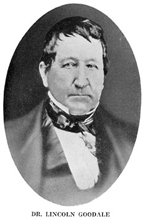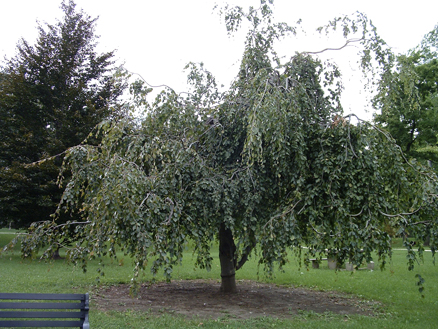
Columbus, Ohio USA
RETURN TO HOMEPAGE www.shortnorth.com
The Short North That Was
Dr. Lincoln Goodale and His Living Legacy
Part Nine
September 2007 Issue
by Beverly Mullet Randall
email info@shortnorth.com
Political Seesaws in Goodale Park
© Photos courtesy of the Columbus Metropolitan Library, Division of Biography, History & Travel
Dr. Lincoln Goodale The Train Controversy
The train controversy first began when tracks for a 19th-century railroad train replica simply appeared in Goodale Park in early May of 1984. The train was a $30,000 amusement park ride for children anonymously donated to the city. When Victorian Commission Chairman Stan Sells objected to the train because the commission had not been told about plans to locate the train in Goodale Park, Recreation and Parks Director Mel Dodge said he would move it to Southview Park.
However, the announcement that the train would be moved to Southview Park ignited dozens of phone calls from north side residents saying they wanted the train to stay. Dodge responded that plans to install the train in Goodale Park would continue with the train being fully operational by June 1. Dodge added that he had lined up four volunteer engineers.
At the May 10 Victorian Commission meeting, the commission voted 6-1 to recommend that Dodge have the half mile of train track that was already installed removed. At this point, Dodge explained that the train was an attempt to do something good for the people and children in the area but they had made the wrong decision in not consulting the Victorian Village Commission or residents. At this meeting, about 35 residents expressed anger that the track had already been laid in the park. They also expressed concerns about children’s safety, noise, accident liability and train and track maintenance.
Few train supporters were present at this meeting. Representative Mike Stinziano assured everyone that Mayor Dana Rinehart had informed him that the train would be moved if residents didn’t want it, but he added that voting against the train might jeopardize future park improvements. This comment infuriated a number of residents, with one calling it blackmail. One commissioner suggested the Village Commission keep the train for at least a week to see if it caused problems. Another suggestion was made to delay the decision until the community could be polled.
On May 15, the Citizen-Journal reported that signatures from 1,400 Victorian Village residents had been gathered to urge the city Recreation and Parks director to keep the train in Goodale Park. One of the circulators of the petition was outraged that the Victorian Village commissioners had voted against the train, saying they had overstepped their bounds. It was reported that three different groups were simultaneously circulating petitions in support of the train and that they had run into each other on the streets while collecting signatures.
The following day, the Citizen Journal reported that when the train proponents had presented Recreation and Parks Director Dodge with a 1,400-signature petition the day before, Dodge had decided to leave the train tracks in Goodale Park a little while longer and suggested they ask the Victorian Village Commission for another hearing before removing the tracks. The next day the Citizen-Journal reported that Stan Sells, chairman of the Victorian Village Commission had scheduled another hearing on the controversial train for next week on May 24.
The May 24 hearing was quite an event, with the Citizen-Journal reporting that the meeting had been “noisier than a train roundhouse.” Nearly 150 people jammed into the Goodale Park Shelter House with those in favor slightly outnumbering those against the train amusement ride, but both sides were reported to be “equally clamorous as they let loose 1 1/2 hours of testimony.” Sells began the meeting by stating that the final decision regarding the train rested with the Parks and Recreation director and not the commission. This statement reportedly did little to quell the throng jammed into the room and crowded in doorways peering over shoulders and straining to hear comments. According to the Citizen-Journal, Sells banged his gavel eight times during the meeting to restore order as participants hooted, applauded and tried to out shout each other, with one woman even standing on a chair at one point to be heard over the crowd.
One resident said the park would get better maintenance with the train there, and his wife, dressed in an engineer cap and red kerchief, said she wanted the park to go back to the kids. Another resident disagreed saying the train should go behind Central High School. When the commission finally voted, they voted 6-1 to recommend that a local group be allowed to work with the city to create a master plan for the park.
When Dodge was informed of the meeting results by telephone that night he is reported to have asked, “But what about the train?” He said he would make a decision about the train the next day. One of the park representatives at the meeting commented, as he surveyed the grumbling crowd leaving, that they had no idea a train would have caused all this. The train eventually ended up at the Columbus Zoo.
A recent photo of the controversial weeping European beech tree planted July 4, 1989 - after being pushed in a wheelbarrow by Joel Bixler during the Doo Dah Parade. Photo/Beverly Mullet Randall Friends of Goodale Park
Shortly after the train controversy, Friends of Goodale Park was formed as a non-profit volunteer group. The group held its first benefit in 1988 to raise money to replace several trees that were felled by severe storms earlier that summer. A local newspaper account of the benefit reported that the theme of the benefit was “Urban Croquet vs. Urban Decay,” and it featured a croquet tournament on vacant land at High Street and Buttles Avenue. Twenty teams backed by 15 local businesses were scheduled to play but some didn’t show up because of rain. Rigsby’s Cuisine Volatile won the tournament.
Doug Ritchey, the self-proclaimed Emperor of the Short North wore a Shakespearean outfit and jogging shoes to play croquet in, topped with a crown. He was accompanied by the Emperor’s Praetorian Guard, the Short Northsmen, Lt. Col. Short North and the Short North Guardian Angel. According to Ritchey, croquet was chosen for the benefit because it was a “pastoral game” and a “gentle people’s game that old people” like him could play. He added that the benefit was an attempt to restore Goodale Park’s beauty and that they hoped the event would be an annual affair that would raise money to plant and illuminate a 50-foot Christmas tree and create a gazebo and croquet green in the park.
More controversy followed the next year revolving around the planting of a weeping European beech tree in Goodale Park. On July 4, 1989, the Friends of Goodale Park (FGP) secretary, and Norm Dolder, FGP president at the time, planted the five-foot tree in recognition of the holiday. As reported in a local newspaper, the secretary said they were unable to find the city’s stake indicating where the tree should be planted when they planted it.
A few days later, the city asked the Friends of Goodale Park to move the tree. They refused saying it was a group effort and it shouldn’t be moved. So the city dug it up and replanted it about 11 feet away – a city forestry representative said the space the tree had originally been planted in was needed for another planting. As a result, the FGP secretary quit, the FGP chairman sided with the city, reportedly saying you couldn’t expect everything to go your way all the time; and the city forester responded by stating that the group had planted the tree in a place that was not where the city had wanted it but he thought the city had a very good relationship with Friends of Goodale Park.
As reported, the landscape architect advising Friends of Goodale Park believed both sides “should give ground” so he went out late on a Saturday night, dug up the tree again, and planted midway between the original planting site and the city’s site 11 feet away from the original site. He also put up signs around the tree on woods posts saying the situation was about politics and urging compromise. In response, it was reported that the city forestry representative said the tree could stay where it was, adding that it wasn’t “that big of a deal.”Looking Back in Wonder
“It was an interesting time in Goodale Park…a very interesting time,” said Norm Dolder, the former FGP President during the train and tree planting controversies, “but I wouldn’t have traded it for anything. We almost had a train in the park that a lot of people didn’t want. Looking back on it now it was fun, but at the time it was very serious. A train would have ruined a good park. It would have drawn a lot of people to the park in the beginning, but over time interest probably would have been lost and it would have sat there.” He adds that the train hearing meetings were chaotic. “People would come to the meetings dressed up in costumes, as train conductors. Stan Sells, who was on the Victorian Village Commission, had to listen to all these things and had a very hard time keeping order.”
Regarding the tree controversy, Dolder says that in the aftermath of the floating European beech episode, the FGP and the city developed a cooperative effort to the benefit of the park. “Alan McKnight, Jack Low, and Barry Weber of the Parks and Recreation Department were “all a great help in turning the park around. Barry Weber was a great help in securing trees and planting them. We worked very closely together in planting trees so they would look good together. You can probably tell I like magnolia trees,” he said, adding that the park has a number of different magnolia varieties. By early 1994, Goodale Park had a magnolia grove of about 75 trees located northwest of the shelter house, making it one of the largest magnolia groves in central Ohio.
Dolder said he lived in the Goodale Park area for 28 years, having moved away about four and a half years ago. “When all of us moved there in the middle 1970s, Goodale Park was a haven for what I call the ‘brown paper bag derelicts’ that slept on the park benches. The grass wasn’t mowed a lot of time. Then it started to turn around, and as the park started being taken care of they left. It really is true that water seeks its own level, and as the park started to improve they weren’t comfortable any more being there and moved on.”
The political seesaw over Goodale Park really does seem to have leveled out. According to Andy Klein, current treasurer for Friends of Goodale Park, the train controversy ended up being a unifying force for residents in the area and led to the creation of Friends of Goodale Park. “It was huge in the sense that people felt it was an outside force intruding on something that needed to be protected (Goodale Park) instead of commercialized. A lot of times neighborhoods only spring into action when they feel threatened.” Klein now describes Friends of Goodale Park as an auxiliary to the city in their unified efforts to do things to protect the park. “What started out as adversarial became positive – that’s why it’s a success now.”©2007 Short North Gazette, Columbus, Ohio. All rights reserved.

